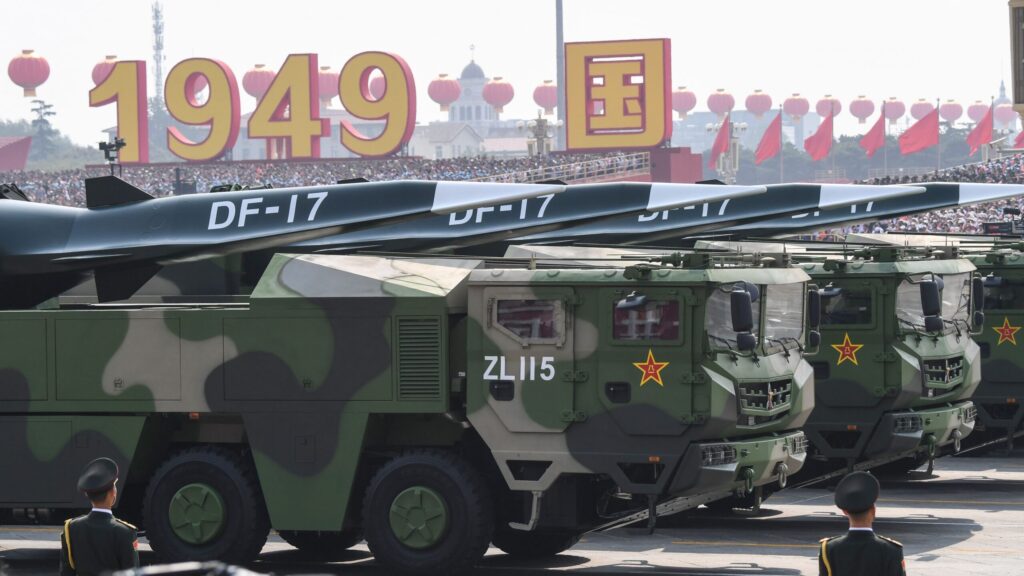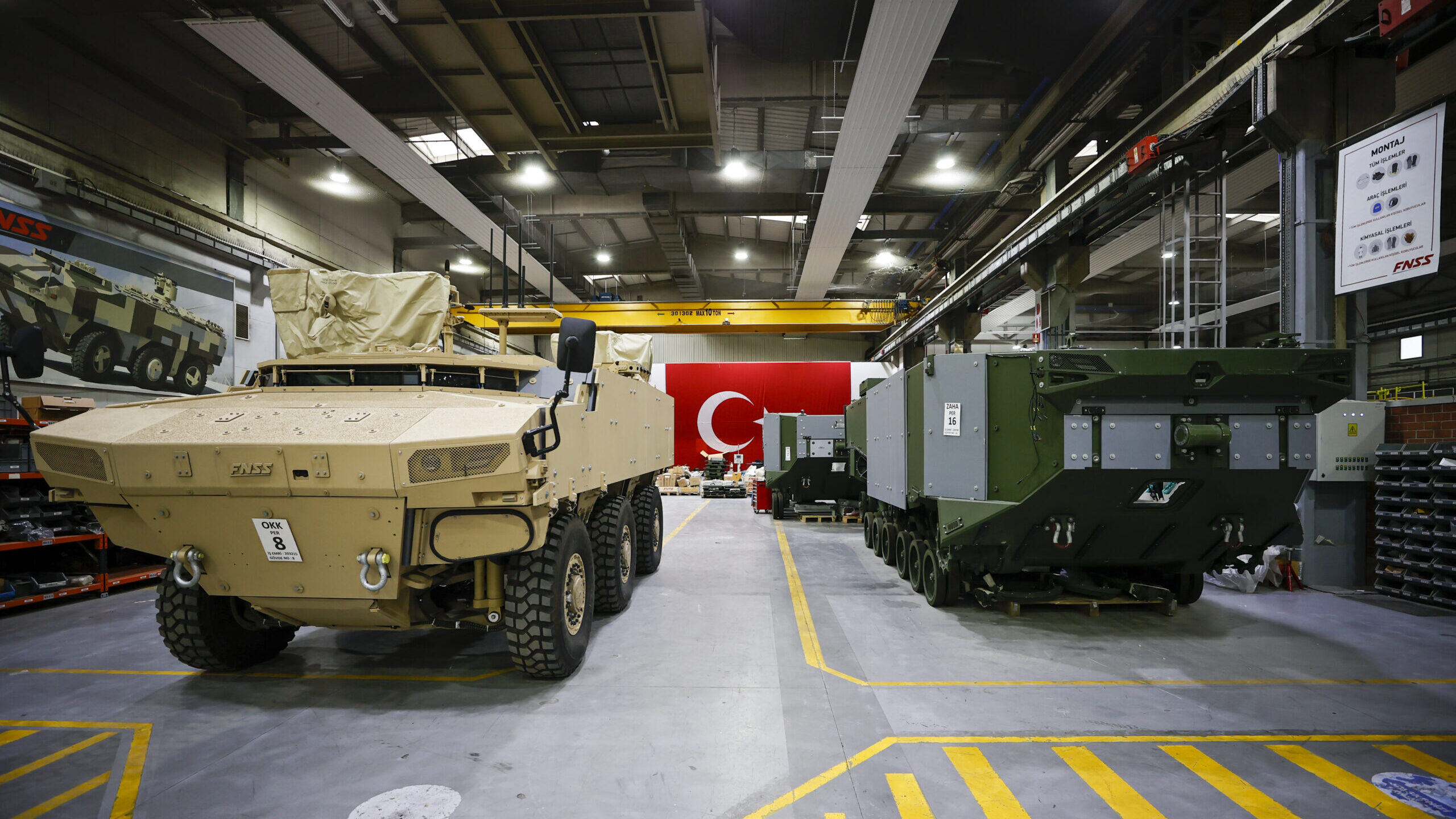Military vehicles carrying DF-17 missiles participate in a military parade at Tiananmen Square in Beijing on October 1, 2019, to mark the 70th anniversary of the founding of the Peoples Republic of China. (Photo by GREG BAKER / AFP) (Photo credit should read GREG BAKER/AFP via Getty Images)
The war in Ukraine has reminded the public that nuclear arms remain useful tools of international statecraft. It is noteworthy that Russia’s nuclear threats, while yet unfulfilled, have included both tactical and strategic nuclear systems, demonstrating that nuclear signaling occurs at multiple levels with a diverse array of systems — but also fitting into an existing understanding of nuclear doctrine.
More complex is the question of how leaders in the People’s Republic of China’s (PRC) view their nuclear arsenal. The PRC is building hundreds of new missile silos, deploying new theater-range ballistic missiles, and potentially developing low-yield warheads. As the DoD’s 2023 report on Chinese military power puts it, the PRC’s “current efforts dwarf previous attempts in both scale and complexity.”
This combination of ambiguous nuclear modernization and ongoing conventional transformation creates dangerous escalation pathways that the United States is ill-prepared to manage. The age of nuclear systems being defined by Cold War thinking is over, and Washington’s understanding of how China views its nuclear arsenal needs to change accordingly.
The final destination of the PRC’s nuclear modernization is the subject of continued debate. While it remains unknown whether the PRC will depart from its traditional No First Use policy, a greater variety of modernized nuclear capabilities affords their leadership the ability to quickly evolve their nuclear doctrine to include coercive nuclear signaling and asymmetric escalation. Simply put, a modernized nuclear arsenal expands their available deterrent and coercive options, and Washington should not be complacent to believe that overt nuclear coercion is a uniquely Russian tactic.
These new and expanded nuclear capabilities combined with the PRC’s already advanced conventional strike systems introduce tremendous uncertainty in US-PRC escalation dynamics. With respect to conventional operations, the PRC’s published concepts call for aggressive strike operations against key adversary nodes should conflict become inevitable. These same documents, such as the Science of Military Strategy also outline strategies that, to Western thinking, blur the line between nuclear and conventional escalation. The combination of an aggressive conventional targeting doctrine with precise, discriminate nuclear weapons, and powerful non-kinetic capabilities highlights what we call in a just-released CNAS report “the conventional-nuclear crossfade.”
In this “crossfade” zone, aggressive conventional operations may hold equal or greater escalation risks than nonstrategic nuclear strikes, making the latter, almost paradoxically, more attractive and tolerable. In the world of precision weapons, cyber, and electronic warfare, much of the collateral damage of nuclear arms can be constrained by careful targeting and lower yield warheads. As a result, the escalation domain is transformed into a miasma of uncertainty, with nonstrategic nuclear escalation appearing more useful and manageable than some conventional operations.
The quintessential example of the crossfade lies in the escalation implications of a precise, nonstrategic nuclear strike targeting naval vessels or a remote island, versus a conventional strike on US critical domestic infrastructure or essential nuclear command and control systems. What would the appropriate US response be to a nonstrategic nuclear weapon that destroys a single ship, or destroys an isolated base in vast expanse of ocean?
We want to be clear here. The PRC’s ongoing modernization creates the distinct possibility for this future. It is up to their leadership to clarify the objectives of their modernization activities, as the existing ambiguity increases the salience of the conventional-nuclear crossfade and its associated risks.
Unfortunately, regardless of declared or undeclared PRC intent, the United States is ill-prepared to manage the current and future escalation dynamics stemming from the conventional-nuclear crossfade. In the Indo-Pacific, US thinking about nuclear escalation remains inappropriately tied to the European theater and the Cold War, and too often assumes the deterrent effects of nuclear overmatch will endure. Traditional notions of assured retaliation, or today’s language of “catastrophic consequences,” may lack credibility in the Indo-Pacific, where the archipelagic nature of the theater creates the opportunity for a variety of highly limited nuclear strikes. Moreover, within the context of a hypothetical US-PRC conflict, longstanding assumptions around strategic nuclear stability preventing tactical nuclear escalation would be acutely challenged should the conflict protract. PRC leadership may perceive nonstrategic nuclear strikes as more viable given dwindling conventional stockpiles.
The concern deepens when one examines the limitations of US nonstrategic nuclear signaling and response options. Signaling with low-yield, submarine launched ballistic missiles is a dangerous endeavor in a conflict as it requires unmasking a vital strategic deterrence asset, a ballistic missile submarine. While using a nuclear cruise missile from an attack submarine does not have these risks, it would likely require reassigning, even temporarily, forces from key conventional missions. Fighters and bombers can be useful signaling tools, but have a similar, albeit less acute tradeoff between conventional and nuclear missions, and can require positioning on allied territory. ICBMs could be theoretically employed for signaling purposes but are strategic weapons and would, at a minimum, have consequences for deterrence beyond the immediate conflict. Unfortunately, attempts to open these kinds of planning discussions are often viewed with skepticism by operational forces and instead passed on to STRATCOM.
Ultimately, the United States must undertake a significant re-examination of its conventional-nuclear integration efforts and develop new operational concepts for theater nuclear deterrence. This must begin with senior decision-makers, who must reckon with the troubling logic of theater nuclear use and the current limits on US responses. Rather than dismiss, ignore, or overlook conventional-nuclear integration discussions, US operational leaders must understand that China’s nuclear future is dangerous and uncertain, and that the United States is ill-prepared for this ambiguous future. This reckoning requires senior decisionmakers to look beyond the PRC’s longstanding declaratory policy, which the current modernization already calls into question, and accept new rules are in place.
Moreover, conventional-nuclear integration must be fundamentally re-prioritized. For too long, US conventional-nuclear integration, planning, and response exercises have featured only as “add-on” or last-day activities. The United States can no longer afford to underestimate not simply the deterrent value of conventional-nuclear integration but also its operational utility. By integrating nuclear operations and conventional exercises, US forces can demonstrate a credible ability to persist and operate through a nuclear strike. Such demonstrations increase deterrence and lessen the potential for the PRC to perceive an opportunistic opening for asymmetric escalation.
Planning discussions must also correspond with new concepts to visibly generate theater nuclear forces as a signaling mechanism. Air Force dual-capable fighters and bombers are likely the best option for these operations in the Pacific. However, the Air Force must develop the procedures and tactics to support these operations across the theater while accounting for the potential tradeoffs with conventional operations. Theater nuclear force generation also comes with political challenges associated with positioning nuclear weapons on allied territory. The United States should thus develop and exercise deployments in the non-contiguous states and territories first, while leaving the door open to cooperation with willing allies.
Ultimately, existing US thinking around nuclear deterrence is dangerously reliant on outdated concepts directly tied to the contours and geography of the Cold War. The PRC’s rapid and transformative nuclear modernization demands a departure from those concepts and the creation of a new deterrent approach that reckons with the uncomfortable realities of the conventional-nuclear crossfade. In this emerging Indo-Pacific era of nuclear deterrence, the United States cannot afford to be caught off guard.
Andrew Metrick is a Fellow with the Defense Program at CNAS. Prior to joining CNAS, he was a campaign analyst and wargamer at Northrop Grumman.
Philip Sheers is a Research Assistant with the Defense Program at CNAS. His research covers nuclear deterrence, great power conflict, and defense industrial base and defense innovation issues.











